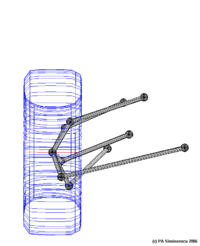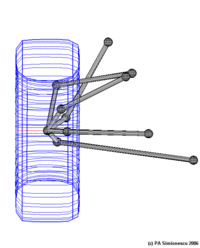- Multi-link suspension
-
Multi-link rear suspension of the 5-link type 
rear view

top view
A multi-link suspension is a type of vehicle suspension design typically used in independent suspensions, using three or more lateral arms, and one or more longitudinal arms.[citation needed] A wider definition considers any independent suspensions having 3 control arms or more multi-link suspensions. [1] These arms do not have to be of equal length, and may be angled away from their 'obvious' direction.
Typically each arm has a spherical joint (ball joint) or rubber bushing at each end. Consequently they react to loads along their own length, in tension and compression, but not in bending. Some multi-links do use a trailing arm or wishbone, which has two bushings at one end.
On a front suspension one of the lateral arms is replaced by the tie-rod, which connects the rack or steering box to the wheel hub.
In order to simplify understanding it is usual to consider the function of the arms in each of three orthogonal planes.
Solid Axle Configuration
For a solid axle vehicle the multi link suspension provides control of the axle during suspension cycling and to locate the axle under the vehicle. The most common[citation needed] is the 4 link with panhard bar. This is found in many cars and pickup trucks. The 4 link is also used heavily in off road racing and drag racing. The 4 link for a solid axle has a few variations such as the triangulated 4 link and double triangulated 4 link. Although common in off-road vehicles these are not commonly found on the street.
Plan view
The arms have to control toe/steer and lateral compliance. This needs a pair of arms longitudinally separated.
Front view
- Independent Suspension
The arms have to control camber, particularly the way that the camber changes as the wheel moves up (into jounce, or bump) and down into rebound or droop.
- Solid Axle Suspension
In a solid axle suspension the upper arms may have an angle of at least 45 degrees between them, to prevent the axle from moving from side to side while allowing the axle to articulate and move freely up and down.
Side view
- Independent Suspension
The arms have to react traction and braking loads, usually accomplished via a longitudinal link. They also have to control caster. Note that brake torques also have to be reacted - either by a second longitudinal link, or by rotating the hub, which forces the lateral arms out of plane, so allowing them to react 'spin' forces, or by rigidly fixing the longitudinal link to the hub.
- Solid Axle Suspension
For a solid axle the lower arms control forward and backward motion, the upper arms control forward and backward rotation. This rotation is present under acceleration and braking.
Advantages of multi-link suspension
- Benefit of independent suspension
Multi-link suspension allows the auto designer the ability to incorporate both good ride and good handling in the same vehicle.
In its simplest form, multi-link suspension is orthogonal—i.e., it is possible to alter one parameter in the suspension at a time, without affecting anything else. This is in direct contrast to a double wishbone suspension, where moving a hardpoint or changing a bushing compliance will affect two or more parameters.
Advantages also extend to off-road driving. A multi-link suspension allows the vehicle to flex more; this means simply that the suspension is able to move more easily to conform to the varying angles of off-road driving. Multi-link-equipped vehicles are ideally suited for sports such as desert racing.[citation needed] In desert racing, the use of a good sway bar is needed to counter body roll.
- Benefits of solid-axle multi-link suspension
The benefit of the triangulated and double-triangulated arrangement is that they do not need a panhard bar. The benefits of this are increased articulation and potential ease of installation. The multi-link for solid axle offers a benefit over the independent multi-link in that it is significantly cheaper and much less complex to build.
Disadvantages of multi-link suspension
Multilink suspension is costly and complex. It is also difficult to tune the geometry without a full 3D computer aided design analysis. Compliance under load can have an important effect and must be checked using a multibody simulation software.
See also
References
- ^ Mark Wan. "AutoZine Technical School - Suspension". Autozine.org. http://www.autozine.org/technical_school/suspension/tech_suspension21.htm#Multi. Retrieved 2011-11-13.
Adams, H. (1993). Chassis Engineering New York, New York, Penguin Putnam
Milliken, W.F., Milliken, D. (2002) Chassis Design: Principles and Dynamics, SAE International
External links
Categories:- Automotive suspension technologies
Wikimedia Foundation. 2010.
